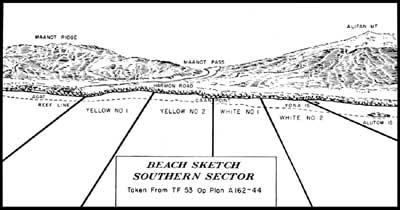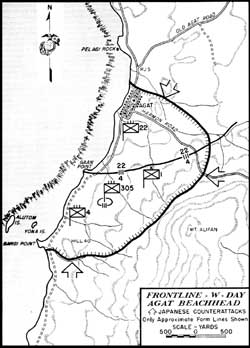| Marines in World War II Commemorative Series |
|
LIBERATION: Marines in the Recapture of Guam by Cyril J. O'Brien Colonel Suenaga Attacks Colonel Tsunetaro Suenaga, commanding officer of the 38th Regiment, from his command post on Mount Alifan, had seen the Americans overwhelm his forces below. Desperate to strike back, he telephoned General Takashina at 1730 to get permission for an all-out assault to drive the Marines into the sea. He had already ordered his remaining units to assemble for the counterattack. The 29th Division commander was not at first receptive. Losses would be too high and the 38th Regiment would serve better defending the high ground and thereby threatening the American advance. Reluctantly, however, Takashina gave his permission, and ordered the survivors to fall back on Mount Alifan if the attack failed, which he was certain it would. Eventually Colonel Suenaga was forced to share the general's pessimism, for he burned his regiment's colors to prevent their capture. At the focal point of the enemy's attack from the south, Hill 40, the brunt of the fighting fell upon First Lieutenant Martin J. "Stormy" Sexton's Company K, 3d Battalion, 4th Marines. The enemy's 3d Battalion, 38th Regiment coming north from reserve positions was still relatively intact. In the face of Japanese assaults, the company held, but just barely. Sexton recalls Lieutenant Colonel Shapley's assessment of the night's fighting: "If the Japanese had been able to recapture Hill 40, they could have kicked our asses off the Agat beaches." Major Anthony N. "Cold Steel" Walker, S-3 (operations officer) of the 3d Battalion, recalled that the Japanese, an estimated 750 men, hit the company at about 2130, with the main effort coming to the left or east of the hill. He remembered:
Along the rest of the Marine front, and in the reserve areas, the fighting was hot and heavy as the rest of the 38th attacked. Colonel Suenaga pushed his troops to attack again and again, in many cases only to see them mowed down in the light of American flares. No novice to Japanese tactics, General Shepherd had anticipated this first night's attack and was ready.
Enemy reconnaissance patrols were numerous around 2130, trying to draw fire and determine Marine positions. Colonel Suenaga was out in front of the center thrust which began at 2330 after a brisk mortar flurry on the right flank of the 4th Marines. The Japanese came on in full force, yelling, charging with their rifles carried at high port, and throwing grenades. The Marines watched the dark shadows moving across the skyline under light of star shells from the ships. Men lined up hand grenades, watched, waited, and then reacted. The Japanese were all around, attempting to bayonet Marines in their foxholes. They even infiltrated down to pack-howitzer positions in the rear of the front lines. It was the same for the 22d Marines. A whole company of Japanese closed to the vicinity of the regimental command post. The defense here was held largely by a reconnaissance platoon headed by Lieutenant Dennis Chavez, Jr., who personally killed five of the infiltrators at point blank range with a Thompson sub-machine gun. Four enemy tanks in that same attack lumbered down Harmon Road. There they met a bazooka man from the 4th Marines, Private First Class Bruno Oribiletti. He knocked out the first two enemy tanks and Marine Sherman tanks of Lieutenant James R. Williams' 4th Tank Company platoon finished off the rest. Oribiletti was killed; he was posthumously awarded the Navy Cross for his bravery. Enemy troops of the 38th also stumbled into the barely set up perimeter of the newly arrived 305th Infantry and paid heavily for it. After one day and night of furious battle the 38th ceased to exit. Colonel Suenaga, wounded in the first night's counterattack, continued to flail at the Marines until he, too, was cut down. Takashina ordered the shattered remnants of the regiment north to join the reserves he would need to defend the high ground around Fonte Ridge above the Asan-Adelup beach head. The general would leave his troops on Orote to fend for themselves.
|




